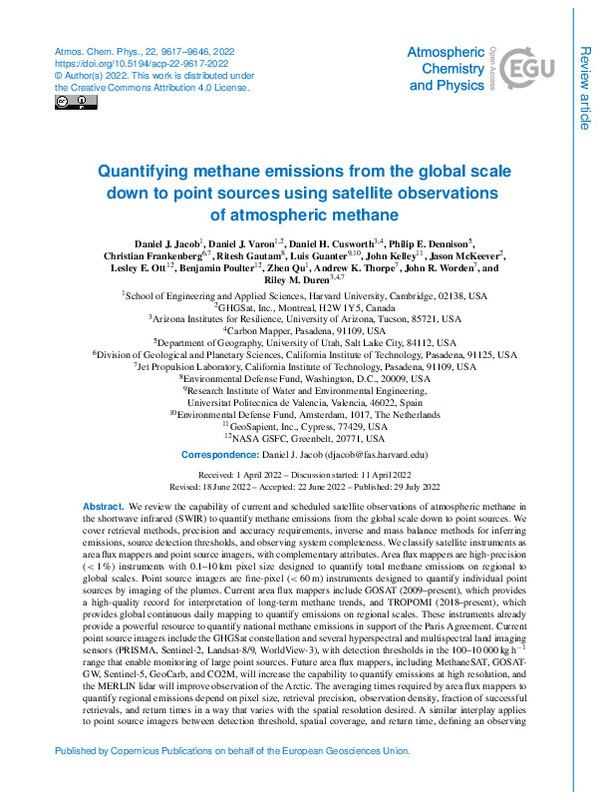JavaScript is disabled for your browser. Some features of this site may not work without it.
Buscar en RiuNet
Listar
Mi cuenta
Estadísticas
Ayuda RiuNet
Admin. UPV
Quantifying methane emissions from the global scale down to point sources using satellite observations of atmospheric methane
Mostrar el registro sencillo del ítem
Ficheros en el ítem
| dc.contributor.author | Jacob, Daniel J.
|
es_ES |
| dc.contributor.author | Varon, Daniel J.
|
es_ES |
| dc.contributor.author | Cusworth, Daniel H.
|
es_ES |
| dc.contributor.author | Dennision, Philip E.
|
es_ES |
| dc.contributor.author | Frankenberg, Christian
|
es_ES |
| dc.contributor.author | Gautam, Ritesh
|
es_ES |
| dc.contributor.author | Guanter-Palomar, Luis María
|
es_ES |
| dc.contributor.author | Kelley, John
|
es_ES |
| dc.contributor.author | McKeever, Jason
|
es_ES |
| dc.contributor.author | Ott, Lesley E.
|
es_ES |
| dc.contributor.author | Poulter, Benjamin
|
es_ES |
| dc.contributor.author | Qu, Zhen
|
es_ES |
| dc.contributor.author | Thorpe, Andrew K.
|
es_ES |
| dc.contributor.author | Worden, John R.
|
es_ES |
| dc.contributor.author | Duren, Riley M.
|
es_ES |
| dc.date.accessioned | 2024-01-10T19:02:24Z | |
| dc.date.available | 2024-01-10T19:02:24Z | |
| dc.date.issued | 2022-07-29 | es_ES |
| dc.identifier.issn | 1680-7324 | es_ES |
| dc.identifier.uri | http://hdl.handle.net/10251/201719 | |
| dc.description.abstract | [EN] We review the capability of current and scheduled satellite observations of atmospheric methane in the shortwave infrared (SWIR) to quantify methane emissions from the global scale down to point sources. We cover retrieval methods, precision and accuracy requirements, inverse and mass balance methods for inferring emissions, source detection thresholds, and observing system completeness. We classify satellite instruments as area flux mappers and point source imagers, with complementary attributes. Area flux mappers are high-precision (< 1 %) instruments with 0.1-10 km pixel size designed to quantify total methane emissions on regional to global scales. Point source imagers are fine-pixel (< 60 m) instruments designed to quantify individual point sources by imaging of the plumes. Current area flux mappers include GOSAT (2009-present), which provides a high-quality record for interpretation of long-term methane trends, and TROPOMI (2018-present), which provides global continuous daily mapping to quantify emissions on regional scales. These instruments already provide a powerful resource to quantify national methane emissions in support of the Paris Agreement. Current point source imagers include the GHGSat constellation and several hyperspectral and multispectral land imaging sensors (PRISMA, Sentinel-2, Landsat-8/9, WorldView-3), with detection thresholds in the 100-10 000 kg h(-1) range that enable monitoring of large point sources. Future area flux mappers, including MethaneSAT, GOSAT-GW, Sentinel-5, GeoCarb, and CO2M, will increase the capability to quantify emissions at high resolution, and the MERLIN lidar will improve observation of the Arctic. The averaging times required by area flux mappers to quantify regional emissions depend on pixel size, retrieval precision, observation density, fraction of successful retrievals, and return times in a way that varies with the spatial resolution desired. A similar interplay applies to point source imagers between detection threshold, spatial coverage, and return time, defining an observing system completeness. Expanding constellations of point source imagers including GHGSat and Carbon Mapper over the coming years will greatly improve observing system completeness for point sources through dense spatial coverage and frequent return times. | es_ES |
| dc.description.sponsorship | This research has been supported by the Collaboratory to Advance Methane Science (CAMS) and the National Aeronautics and Space Administration, Earth Sciences Division (grant no. NNH20ZDA001N-CMS). | es_ES |
| dc.language | Inglés | es_ES |
| dc.publisher | Copernicus GmbH | es_ES |
| dc.relation.ispartof | ATMOSPHERIC CHEMISTRY AND PHYSICS | es_ES |
| dc.rights | Reconocimiento (by) | es_ES |
| dc.subject.classification | FISICA APLICADA | es_ES |
| dc.title | Quantifying methane emissions from the global scale down to point sources using satellite observations of atmospheric methane | es_ES |
| dc.type | Artículo | es_ES |
| dc.identifier.doi | 10.5194/acp-22-9617-2022 | es_ES |
| dc.relation.projectID | info:eu-repo/grantAgreement/NASA//NNH20ZDA001N-CMS/ | es_ES |
| dc.rights.accessRights | Abierto | es_ES |
| dc.contributor.affiliation | Universitat Politècnica de València. Escuela Técnica Superior de Ingenieros de Telecomunicación - Escola Tècnica Superior d'Enginyers de Telecomunicació | es_ES |
| dc.description.bibliographicCitation | Jacob, DJ.; Varon, DJ.; Cusworth, DH.; Dennision, PE.; Frankenberg, C.; Gautam, R.; Guanter-Palomar, LM.... (2022). Quantifying methane emissions from the global scale down to point sources using satellite observations of atmospheric methane. ATMOSPHERIC CHEMISTRY AND PHYSICS. 14:9617-9646. https://doi.org/10.5194/acp-22-9617-2022 | es_ES |
| dc.description.accrualMethod | S | es_ES |
| dc.relation.publisherversion | https://doi.org/10.5194/acp-22-9617-2022 | es_ES |
| dc.description.upvformatpinicio | 9617 | es_ES |
| dc.description.upvformatpfin | 9646 | es_ES |
| dc.type.version | info:eu-repo/semantics/publishedVersion | es_ES |
| dc.description.volume | 14 | es_ES |
| dc.relation.pasarela | S\488805 | es_ES |
| dc.contributor.funder | Collaboratory to Advance Methane Science | es_ES |
| dc.contributor.funder | National Aeronautics and Space Administration, EEUU | es_ES |








